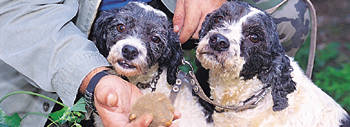TARTUFO
DI VOLTERRA
Around these parts they are classified in two categories. There are
the despised "cicciai" who only do it for money: they move
by night, leaving the car in one place and having a friend take them
to another so that no one will discover their secret. Then there are
the "sportivi", who do it for love and never leave home
without a slab of bacon and the ever-present flask of wine.
These are the truffle hunters from Volterra who, from October to February,
accompanied by their dogs (always mutts because mixed breeds have
a greater sense of smell), go out in the woods and countryside looking
for the precious white truffle of Volterra, the Tuber magnatum Pico.
Tuber because the truffle is an underground fungus that has a tuberous
form, magnatum because it is so precious as to be used only by the
wealthy (the magnates) and Pico from the name of the doctor who first
described and wrote about it in the eighteenth century.
The truffle can boast a host of more or less illustrious admirers
ever since the times of Jacob the Patriarch; these include Plutarch,
Cicero, Emperor Charles V, Napoleon, as well as Camillo Benso, Count
of Cavour, who used to present it to his counterparts in diplomacy
to facilitate future collaborative relations.
The truffles that everyone covets are the ones that grow near what
is called in this area the sanguinello: a plant with small, black
berries whose truffle is easily recognized for the light red stripes
of its pulp and for its intense and pleasing aroma. The form depends
on the soil’s consistency: it is regular if it grows in crumbly
earth or flat and irregular if it grows in very compact terrain. As
precious and fleeting as all rare essences, it can only be kept several
days in a cool place, wrapped in a cloth or slightly absorbent paper,
or else with rice in a glass jar.
It is always eaten raw after having been cleaned by a loving brush
under running water. Using a truffle cutter it is sliced into thin
pieces over hot dishes such as pappardelle or used in the delicious
truffle flan.

